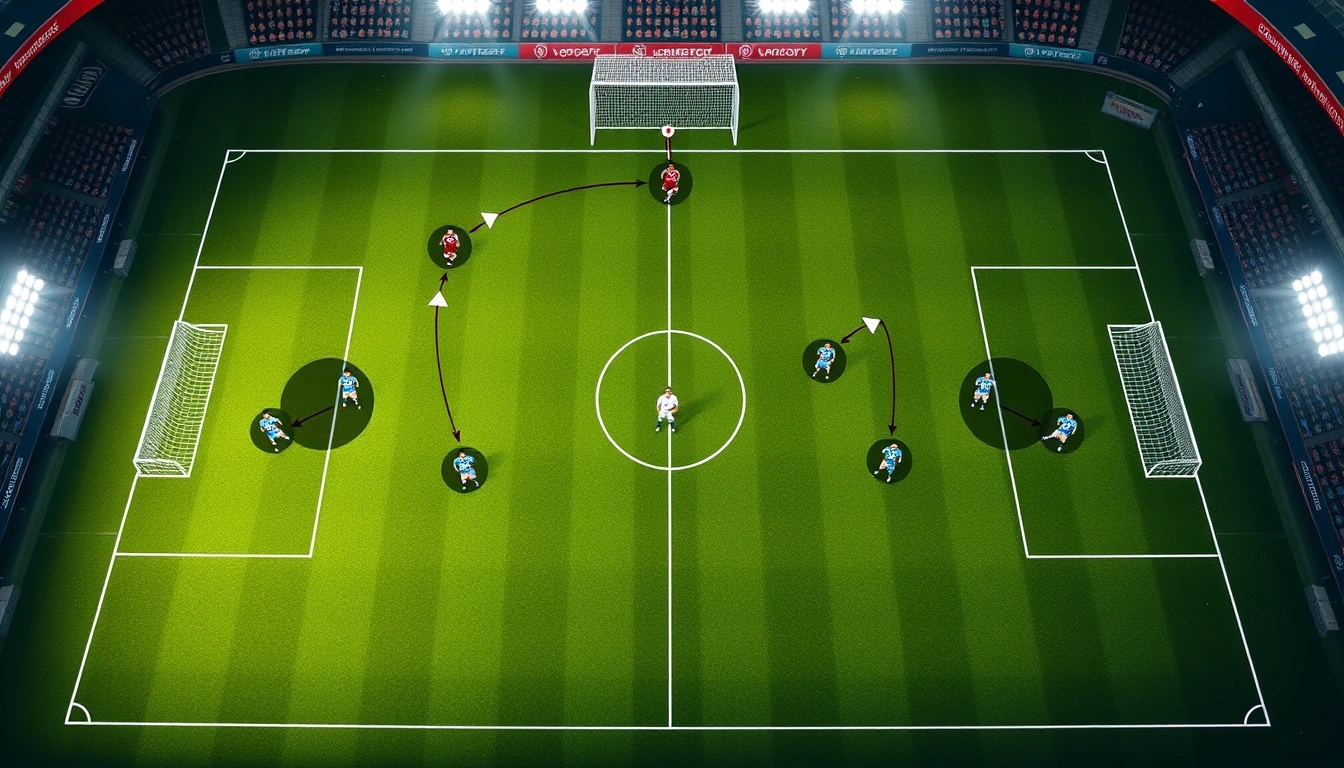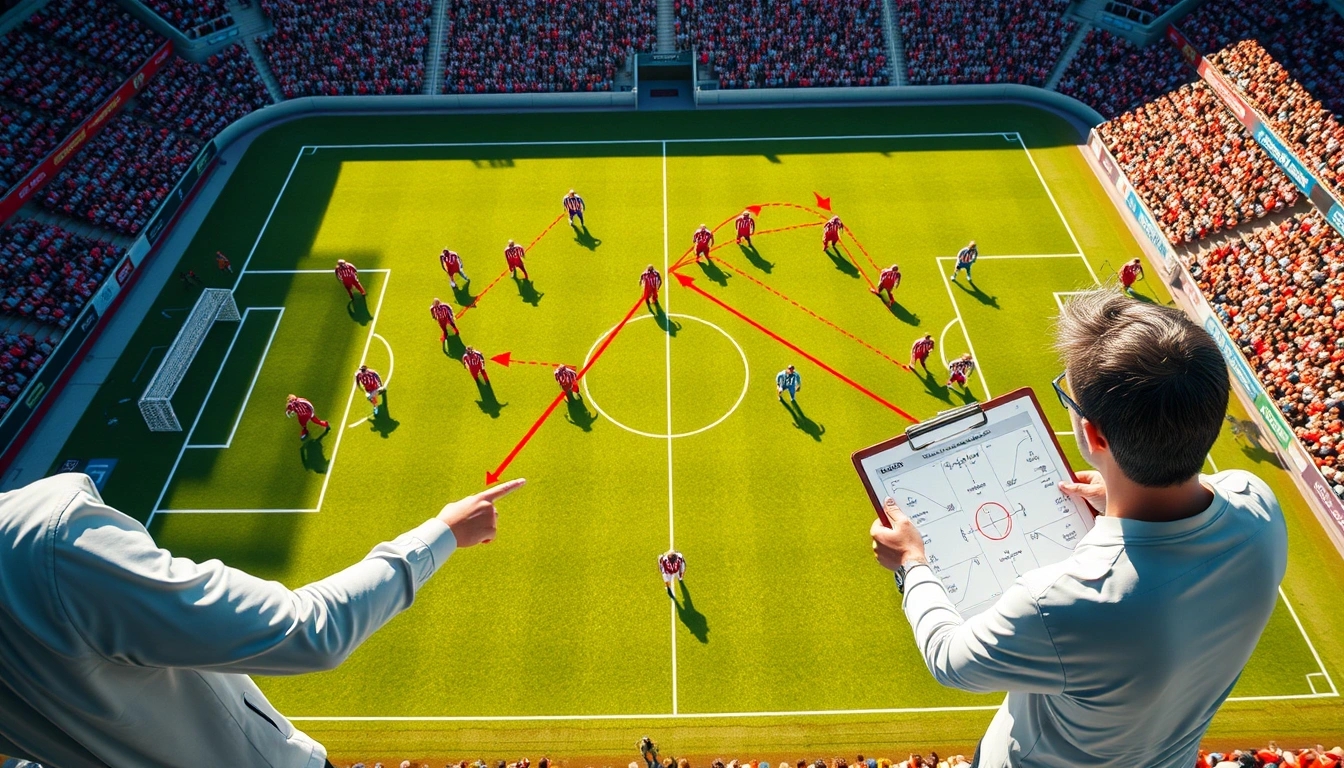Football formations might seem like a secret code to the untrained eye — rows of numbers like 4-4-2 or 3-5-2 that coaches throw around like they’re magic spells. But here’s the deal: these numbers actually tell you a lot about how a team plans to attack, defend, and basically survive on the pitch. If you’re new to the beautiful game, understanding formations is like unlocking a cheat code to knowing what’s going on behind the scenes.
What Is a Football Formation Anyway?
At its core, a formation is just a way of arranging players on the field. Think of it as a blueprint or a game plan laid out before kickoff. The numbers represent how many players are assigned to defense, midfield, and attack, in that order. For example, a 4-4-2 means four defenders, four midfielders, and two forwards. Simple, right? But the real trick is how these players move and interact within those roles.
- Why does it matter? Because formations influence how a team controls the game, whether they’re pressing hard or sitting back and waiting for a counterattack.
- Numbers aren’t everything. A 4-4-2 from one team might look completely different from another, depending on player style and coach tactics.
Common Formations and Their Roles
Let’s break down some crowd favorites:
| Formation | Basic Setup | Purpose |
|---|---|---|
| 4-4-2 | 4 Defenders, 4 Midfielders, 2 Forwards | Balanced approach, good for both attack and defense |
| 4-3-3 | 4 Defenders, 3 Midfielders, 3 Forwards | Offensive, high pressure on opponents |
| 3-5-2 | 3 Defenders, 5 Midfielders, 2 Forwards | Midfield dominance and flexibility |
| 5-4-1 | 5 Defenders, 4 Midfielders, 1 Forward | Defensive, designed to frustrate attackers |
The Classic 4-4-2
Ah, the trusty 4-4-2 — the grandpa of formations. This setup has been around forever and still pops up in games here and there. It’s like a Swiss Army knife: reliable, straightforward, but maybe a bit old-school. It gives a team a solid defensive base while keeping options open for attacking through the wings or center. But critics say it’s a bit rigid for today’s lightning-fast, fluid football.
Attack-Focused 4-3-3
If you love watching goals fly in, 4-3-3 is your buddy. This formation sends three forwards up front, often with wingers who can cut inside or whip in crosses. It’s aggressive, high-energy, and sometimes leaves the defense exposed — but hey, no risk, no reward, right? Coaches use it when they want to dominate possession and keep the pressure on.
Defensive Formations: Playing It Safe
Sometimes, teams just want to park the bus. The 5-4-1 is the go-to for that. With five defenders, it’s like putting a brick wall in front of your goal. But it can be a double-edged sword — while it’s great for shutting down attacks, it often means sacrificing your own chances to score.
How Formations Affect Player Roles
Formations don’t just say where players stand; they tell them what to do. A midfielder in a 4-4-2 might have to run up and down the wings, while in a 3-5-2, the same player could be more central, controlling the game. Defenders might push forward in some setups or stay glued to their line in others. It’s a constant dance of adapting.
Adapting Formations Mid-Game
Football isn’t static. Coaches often tweak formations during matches to respond to what’s happening — maybe switching from a defensive 5-4-1 to a more attacking 4-3-3 if they’re chasing a goal. Players need to be alert and flexible, or else the whole plan falls apart.
Practical Tips for New Players
- Don’t get overwhelmed by the numbers — focus on your role first.
- Watch how your position changes with different formations.
- Ask your coach or teammates if you’re unsure; communication is key.
- Be ready to switch gears mid-game — football is unpredictable!
In the end, formations are tools — not rules set in stone. Understanding them gives you a leg up, but the magic happens when players bring their own style and creativity onto the pitch. So next time you see those numbers, remember: it’s not just math, it’s football strategy in action.
What Is a Football Formation Anyway?
Alright, let’s start from square one. You’ve probably glanced at a football match, noticed the players lined up in some sort of pattern, and wondered, “What’s the deal with all these numbers and shapes on the pitch?” Well, that’s exactly where formations come into play. In the simplest terms, a football formation is just the way a team arranges its players on the field. But don’t let that fool you—it’s way more than just a random lineup. It’s a strategic blueprint that can make or break a game.
Think of a formation as the skeleton of your team’s game plan. It dictates who’s hanging back to defend, who’s pushing forward to attack, and who’s running the midfield hustle. And yes, those numbers you see—like 4-4-2, 4-3-3, or 3-5-2—are shorthand for how many players are assigned to each zone: defenders, midfielders, and forwards.
| Number | Meaning | Role Overview |
|---|---|---|
| 4 | Defenders | Usually the backbone of the defense, stopping attacks and clearing the ball. |
| 4 | Midfielders | Link defense and attack, control the flow, and often create scoring chances. |
| 2 | Forwards | Main attackers, responsible for scoring goals. |
So why should you even care about these numbers? Well, knowing the formation gives you a sneak peek into the team’s mindset. Is the coach playing it safe, stacking the defense? Or are they throwing caution to the wind, sending everyone forward in a full-blown attack? It’s like reading the team’s battle plan.
- Defensive formations tend to have more players at the back, aiming to frustrate opponents and keep clean sheets.
- Attacking formations push more players forward, seeking to overwhelm the opposition with firepower.
- Balanced formations try to keep a little bit of both, hoping to adapt as the game unfolds.
But here’s the kicker: formations aren’t set in stone. They’re more like a starting point. Coaches and players tweak them mid-game, depending on how things are going. Maybe you start with a cautious 4-5-1, but then switch to a 4-3-3 if you’re desperate for goals. It’s a living, breathing thing.
Formation Strategy + Player Roles + Adaptability
In short, a football formation is your team’s game plan on paper (or chalkboard), boiled down to numbers and positioning. It’s the language coaches use to tell players where to be and what to do. And if you’re new to the game, getting a grip on formations is one of the quickest ways to start understanding football beyond just kicking the ball around.
So next time you see those numbers pop up on your screen or program, don’t just skim over them. Dig a little deeper—there’s a whole strategy story hidden there.
Common Formations and Their Roles
Alright, so you’re diving into the world of football formations, and it feels like someone just threw a bunch of numbers at you with zero explanation. Don’t sweat it! Those numbers—like 4-4-2, 4-3-3, or 3-5-2—aren’t just random; they’re a secret code coaches use to try and outsmart the other team. Each setup tries to balance attack, defense, and midfield control in its own quirky way. Let’s break down some of the crowd favorites and get a feel for what they’re all about.
| Formation | Basic Setup | Main Focus | Pros | Cons |
|---|---|---|---|---|
| 4-4-2 | 4 defenders, 4 midfielders, 2 forwards | Balance between defense and attack | Simple, solid, easy to understand | Can be predictable and lack midfield creativity |
| 4-3-3 | 4 defenders, 3 midfielders, 3 forwards | Attack-heavy, pressing high up the pitch | Great for offensive pressure, wide play | Midfield can get overrun if not disciplined |
| 3-5-2 | 3 defenders, 5 midfielders, 2 forwards | Control midfield and flexible wing-backs | Dominates midfield, wing-backs add width | Risky at the back, relies on strong defenders |
So, the 4-4-2 is like the old reliable in football. It’s straightforward, with four defenders holding the line, four midfielders running the middle, and two forwards looking to score. It’s been around forever because it’s easy to get players into their roles without too much fuss. But, here’s the kicker—it can sometimes feel a bit… dull? Like, if you’re going for flair and creativity, this formation might hold you back. It’s solid, yes, but don’t expect fireworks.
Now, the 4-3-3 is where things get spicy. With three forwards, this setup screams “let’s attack!” Coaches love it when they want their team to press high and keep the pressure on the opponent. The midfield trio has a tough job though—holding the middle and linking up with those aggressive forwards. If they slack off, the whole team can get exposed. But when it clicks, it’s a thrilling spectacle of fast breaks and wing play.
- Why choose 4-3-3? You want to dominate the opponent’s half and keep them on their heels.
- Watch out: If your midfielders aren’t disciplined, you’ll get caught chasing shadows.
Then there’s the 3-5-2, a bit of a rebel in the formation world. Three defenders might sound risky, but with five midfielders, you control the center of the park like a boss. The wing-backs in this setup have a dual role—defend when needed and sprint up the flanks to support attacks. It’s like having your cake and eating it too—but only if your defenders are rock solid because they’ll get tested constantly.
Key takeaway:- 4-4-2 old-school, balanced, but sometimes predictable.- 4-3-3 attack-minded, exciting, but midfielders must hustle.- 3-5-2 midfield domination with wing-backs, risky defense.
In the end, no formation is perfect. Coaches pick and tweak based on players, opponents, and sometimes just gut feeling. So next time you see those numbers, remember—they’re not just digits, but a roadmap for how the team plans to dance on the field. And hey, sometimes the best moves come from breaking the rules a bit. Just ask any coach who’s ever thrown in a surprise formation mid-game!
The Classic 4-4-2
formation has been a beloved choice for football teams around the world for decades. You could say it’s the granddaddy of formations—simple, balanced, and reliable. But here’s the million-dollar question: in today’s lightning-fast, ultra-tactical football, is the 4-4-2 still a heavyweight contender or just a nostalgic relic?
First off, let’s break down what the 4-4-2 actually means. Picture the pitch divided into four defenders, four midfielders, and two forwards. This setup offers a neat symmetry, with a solid backline and midfield that can both defend and support the attack. The two strikers up front are typically the main goal threats, working in tandem to stretch defenses and create scoring chances. The midfield four can be a mix of wide wingers and central midfielders, giving flexibility to switch gears between defense and attack.
- Defense: Four defenders usually in a flat line, providing a strong, organized barrier.
- Midfield: Four midfielders split between central roles and wide positions, responsible for linking play and covering the flanks.
- Attack: Two forwards tasked with finishing chances and pressing defenders.
Now, the charm of the 4-4-2 lies in its simplicity and balance. It’s like a Swiss Army knife—doesn’t specialize in anything crazy but gets the job done. Coaches love it for its straightforwardness, making it easier for players to understand their roles without getting lost in complicated tactics. But—and here’s the kicker—football has evolved. The pace is quicker, pressing is relentless, and formations have become more fluid and dynamic.
| Pros of 4-4-2 | Cons of 4-4-2 |
|---|---|
|
|
In modern football, many teams prefer formations like 4-3-3 or 3-5-2 that overload the midfield or wing areas to control possession and press high. The 4-4-2, with its flat midfield four, sometimes struggles to keep up when opponents swarm the middle of the park. But don’t count it out just yet. Some managers swear by it for its defensive solidity and quick counter-attacking potential. It’s like that dependable old pair of boots you can always pull out when you need to get the job done.
Here’s a quick look at how player roles shift in this formation:
Defenders: Stay compact, block crosses, and support midfield.Midfielders: Wide midfielders track back and deliver crosses; central mids link defense and attack.Forwards: One might drop deeper to create space, the other stays forward to finish.
In short, the 4-4-2 is a formation that’s both loved and criticized. It’s not flashy, it’s not overly complicated, but it’s effective—when used right. Is it outdated? Maybe a little. But is it irrelevant? Hardly. Like a classic rock song, it still gets the crowd going when played well.
So, if you’re a new player or a fan trying to wrap your head around football tactics, remember: formations are tools, not rules. The 4-4-2 might not be the trendiest kid on the block, but it’s still got some tricks up its sleeve. And who knows? In football, the old ways sometimes make a stunning comeback.
Attack-Focused 4-3-3
The 4-3-3 formation is like the football equivalent of turning the volume all the way up — it’s loud, aggressive, and all about pushing forward. Imagine three forwards constantly breathing down the necks of defenders, always hunting for that elusive goal. This setup doesn’t mess around; it’s designed to keep the pressure high and the opposition on their heels. Coaches who favor this formation are often the ones who want their team to dominate possession and create a flurry of chances rather than sit back and play it safe.
Why do coaches love the 4-3-3? Well, for starters, it’s incredibly flexible in attack. The three forwards usually consist of a central striker and two wingers who can stretch the field wide, dragging defenders out of position and creating space. Meanwhile, the midfield trio can either be all about controlling the ball or mix defensive duties with creative playmaking. It’s like having a Swiss army knife on the pitch — lots of options depending on how the game unfolds.
- Front Three: The spearhead striker, plus two speedy wingers who can cut inside or whip crosses in.
- Midfield Trio: Often a mix of one holding midfielder and two more attack-minded players, or vice versa.
- Back Four: Standard defensive line, but with fullbacks who often join the attack to provide width.
| Position | Role | Key Attribute |
|---|---|---|
| Striker | Goal scorer, hold-up play | Finishing, strength |
| Wingers | Wide attacks, crosses, cutting inside | Speed, dribbling |
| Midfielders | Ball control, linking play, defensive cover | Vision, stamina |
| Fullbacks | Defend and support attacks on flanks | Endurance, crossing |
Now, here’s the catch — this formation can be a bit of a double-edged sword. Push too hard and suddenly your defense is left exposed like an open goal. Fullbacks bombing forward is great until the opposition counters at lightning speed. It’s a gamble, but one that can pay off big if your team has the stamina and tactical discipline to cover the gaps.
You might wonder, “Isn’t this just a fancy way of saying ‘let’s throw everyone forward and hope for the best’?” Well, not quite. The 4-3-3 demands a lot from players — especially midfielders who have to work their socks off to support both attack and defense. It’s not just about scoring goals; it’s about controlling the game tempo and forcing the other team into mistakes.
Pro Tips for Playing 4-3-3:- Wingers: Stay unpredictable! Cut inside or hug the line to confuse defenders.- Midfielders: Balance is key — don’t get too caught up in attack or you’ll leave your defense hanging.- Defenders: Communication is your best mate; cover for those adventurous fullbacks.
In summary, the 4-3-3 is an exciting, high-risk, high-reward formation that embodies attacking football. It’s no wonder fans love it — goals tend to follow this setup! But it’s not for the faint-hearted or teams lacking fitness and tactical awareness. When it clicks, though, it’s pure football poetry.

Defensive Formations: Playing It Safe
Sometimes in football, it’s not about scoring a gazillion goals but about holding the line and keeping the other lot from scoring at all. Yeah, defense might not get the glory like flashy forwards do, but trust me, it’s what wins you those nail-biting matches. Enter the world of defensive formations, where the main goal is to frustrate, block, and just generally make life miserable for the opposition.
One of the most talked-about defensive setups is the 5-4-1 formation. Now, before you roll your eyes thinking it’s just a boring lineup, hear me out. This formation is like a fortress. Five defenders form a solid backline, four midfielders sit just ahead of them, and a lone striker waits up front, often looking like a lost puppy but doing crucial hold-up work. The idea here? To clog up the middle, deny space, and force the opponents to try their luck from wide angles or long shots.
| Formation | Main Strength | Common Use | Potential Drawback |
|---|---|---|---|
| 5-4-1 | Strong defensive block, hard to break down | Protecting a lead, underdog matches | Limited attacking options, can be too passive |
| 4-5-1 | Midfield dominance, balanced defense | Controlling possession, counterattacks | Striker isolated, less pressure upfront |
Now, the beauty and the curse of defensive formations like 5-4-1 is that they can be maddening for fans who crave goals. It’s like watching paint dry for the most part — all grit, grit, grit, and not much glitter. But coaches love it when the stakes are high and the opposition is strong. It’s a tactical way of saying, “You shall not pass!”
- Why use defensive formations? When you’re the underdog or protecting a slim lead, shoring up the defense can be the smartest move.
- What’s the trade-off? You might kill your own attacking mojo. With fewer players pushing forward, chances dry up.
- Is it boring? Depends who you ask. For purists, it’s chess on grass; for others, a snoozefest.
Of course, defensive formations aren’t just about parking the bus. They require discipline, communication, and stamina. Players in these setups have to be alert every second, ready to intercept, tackle, or clear the ball. Plus, the lone striker often has to be a warrior, holding the ball up and linking play while everyone else focuses on defense.
So next time you see a team line up in a 5-4-1 or similar setup, don’t dismiss it as boring or cowardly. It’s a strategic choice, a battle plan to grind out results when the chips are down. And hey, sometimes defense really does win games.
Quick Tips for New Players on Defensive Formations:
- Stay compact: Don’t leave gaps between defenders.- Communicate constantly: Defense is a team effort.- Be patient: Don’t rush tackles; wait for the right moment.- Support the striker: Even defensive players can help attack.
In the grand scheme of football, defense might not be the flashiest or most exciting, but it’s the backbone. Without it, your shiny attack means zilch. So respect the defenders—they’re the unsung heroes who keep the dream alive.
Understanding the 5-4-1
So, you’ve probably heard the term 5-4-1 formation tossed around by commentators or maybe your coach muttering it under their breath during a nail-biting match. But what’s the deal with this setup? Well, it’s a classic case of “defense first, offense… well, maybe later.” The 5-4-1 is like that stubborn turtle shell—super tough to crack but not exactly built for sprinting after goals. It’s a formation that frustrates opponents to no end, but at the same time, it can seriously cramp your own team’s attacking mojo.
- Defensive Solidity: With five defenders lined up, the main goal here is simple—stop the other team from scoring. It’s like building a brick wall around your goal, making it tough for forwards to find any gaps.
- Midfield Muscle: The four midfielders aren’t just sitting back; they have to work double-time to support the defense and occasionally push forward. But let’s be honest, their main job is to keep things tight and organized.
- Lonely Striker: The single forward upfront often feels like a castaway on an island—cut off from support and having to fend for themselves against a sea of defenders.
| Aspect | Pros | Cons |
|---|---|---|
| Defense | Very strong, hard to break down | Can invite pressure, leading to fatigue |
| Attack | Quick counter-attacks possible | Limited attacking options, isolated striker |
| Midfield Control | Compact, organized midfield | Less creativity, fewer chances created |
Now, here’s where the trade-offs get interesting. If you’re the type who loves watching goals fly in every five minutes, the 5-4-1 might feel like watching paint dry. The formation’s ultra-defensive nature means your team is basically daring the opposition to come at you, hoping to snatch a goal on a counterattack or set-piece. It’s a bit like playing chess, where you’re more focused on not losing than winning outright.
But don’t underestimate it! When executed well, the 5-4-1 can frustrate even the flashiest, most aggressive teams. Imagine a swarm of bees buzzing around a flower that just won’t give up its nectar—that’s the kind of annoyance this formation can cause. Opponents get impatient, make mistakes, and suddenly your lone striker gets a golden chance to pounce.
Practical Tips for Playing 5-4-1:- Defenders: Stay disciplined, communicate constantly, and don’t get drawn out of position.- Midfielders: Balance defense and offense carefully; support the lone striker when possible.- Striker: Be ready to hold up the ball, link play, and exploit counter-attacks.
At the end of the day, the 5-4-1 is a gamble. You’re basically saying, “We’ll defend like our lives depend on it, and if luck’s on our side, we’ll snatch a goal.” For new players, it’s a great lesson in teamwork and discipline but be warned—if you’re itching to be the star goal-scorer, this setup might test your patience. Still, in the chaotic world of football, sometimes the tortoise really does win the race.
So, next time you see a team line up in 5-4-1, remember: it’s not just a boring defensive block, it’s a strategic choice packed with pros, cons, and a whole lot of tactical chess moves.
How Formations Affect Player Roles
When you first glance at a football formation—say, a neat little sequence like 4-3-3 or 3-5-2—it might seem like just a bunch of numbers tossed around. But here’s the kicker: those numbers are more than just digits; they’re the secret code that shapes what every single player on the pitch is supposed to do. It’s like a blueprint for chaos, giving structure to what would otherwise be a mad scramble chasing a ball around.
Think of formations as the coach’s way of assigning roles in a play, except the stage is 100 yards long and the actors are running at full speed. Each setup shifts responsibilities, sometimes drastically. For instance, in a 4-4-2, the midfielders might have a pretty balanced job—support the defense but also feed the forwards. But switch that to a 4-3-3, and suddenly those midfielders are expected to be more creative or defensive, depending on the coach’s style.
| Formation | Typical Player Roles | Impact on Play Style |
|---|---|---|
| 4-4-2 | Two strikers, balanced midfield, four defenders | Balanced attack and defense; straightforward wing play |
| 4-3-3 | Three forwards, creative midfield trio, four defenders | More attacking, pressing high, wing-focused offense |
| 3-5-2 | Wing-backs, midfield-heavy, two forwards | Control midfield, flexible defense, wing-backs provide width |
Now, let’s get a bit messy and real: these roles aren’t set in stone. A winger in a 4-3-3 might be told to hug the sideline and whip in crosses, but in a different game, that same player might be tasked with cutting inside and taking shots. It’s like the formation gives a general direction, but the actual job depends on the match, the opponent, and sometimes, just the mood of the coach.
- Defenders in formations with three at the back (like 3-5-2) often have to cover more ground and communicate like mad to keep the defense tight.
- Midfielders might be box-to-box in a 4-4-2 but become specialized creators or destroyers in a 4-3-3.
- Forwards can be lone strikers in defensive setups, or part of a trio in attack-heavy formations.
Here’s a quick snapshot of how player roles can shift with formations:
Role | 4-4-2 | 4-3-3 | 5-4-1------------- | ---------------------- | ---------------------- | ----------------------Striker | Partner up front | Lone or part of trio | Lone striker, hold-up playMidfielder | Balanced attack/defense| Creative/attacking | Defensive, support defenseWing-back | Traditional winger | Wide forward | Defensive wing-backDefender | Four at back, flat line| Four at back, high line| Five at back, deep line
So, if you’re new to football, don’t just memorize numbers—try to see formations as a living, breathing guide that tells each player where to hustle, when to press, and how to link up with teammates. It’s less about rigid rules and more about understanding your role in a constantly shifting puzzle.
And remember, the magic (or chaos) happens when players interpret these roles with their own flair. Sometimes, a striker in a 4-4-2 might drop deep and create chances, confusing the opposition and delighting fans. Other times, a wing-back in a 3-5-2 might bomb forward so aggressively it turns into an extra attacker.
In the end, formations set the stage, but the players write the story. Knowing how roles shift with different setups isn’t just helpful—it’s essential if you want to get inside the game’s head and maybe, just maybe, outsmart the other team.
Adapting Formations Mid-Game
Football is anything but predictable. One minute, a team is cruising with a solid 4-3-3, pressing high and looking lethal in attack, and the next, they’re scrambling to switch to a 5-4-1 just to keep a stubborn opponent at bay. Formations aren’t set in stone; they’re more like living, breathing frameworks that coaches tweak constantly. But why do they do this, and what does it mean for the players on the pitch? Let’s dive in.
First off, imagine a coach sitting on the sidelines, eyes darting like a hawk, spotting weaknesses and opportunities. The game’s rhythm changes, injuries happen, or maybe the other team suddenly finds their groove. That’s when the magic (or chaos) of formation shifts kicks in. A coach might decide to add an extra midfielder to control the center, or push a defender forward to support attacks. It’s like playing chess but at 100 miles per hour.
- Why switch mid-game? To respond to the opposition’s tactics, cover for tired legs, or chase a goal.
- What changes? Player roles, positioning, and even mindset.
- Who leads the change? Usually the coach, but sometimes a savvy captain might signal a tweak.
Now, let’s talk about players. They’re not robots following a fixed plan. When the formation shifts, they must adapt on the fly — maybe a winger suddenly becomes a wing-back, or a striker drops deeper to help midfield. This demands a sharp understanding of the game and quick thinking. Not every player thrives under these sudden changes, which is why versatility is gold in football.
| Formation Before | Formation After | Player Impact |
|---|---|---|
| 4-3-3 | 4-5-1 | Wingers drop back, lone striker holds ball up |
| 3-5-2 | 5-3-2 | Wing-backs become full-backs, more defensive focus |
| 4-4-2 | 4-2-3-1 | Midfield reshuffle, attacking midfielder added |
But here’s a kicker — sometimes these changes backfire spectacularly. A team might lose its attacking spark or become disorganized, giving the opposition a sniff of victory. It’s a gamble, and coaches often have to trust their gut rather than just the stats.
So next time you watch a game and see the lineup numbers changing on your screen, remember it’s not just a fancy graphic. It’s a tactical tug-of-war, with coaches and players constantly adjusting to the unpredictable flow of football. Adapting formations mid-game is as much an art as it is a science. And for new players, embracing this fluidity can be the difference between being a benchwarmer and a game-changer.
- Practical tip: Always stay alert and communicate with teammates — formation changes mean new roles, and everyone needs to be on the same page.
- Remember: Flexibility beats rigidity. The best players can switch gears without missing a beat.

Practical Tips for New Players
So, you’ve just laced up your boots and stepped onto the pitch, staring down at that formation your coach just shouted out. Feeling a bit lost? Don’t sweat it — football formations might look like a secret code at first, but with a little patience and some street-smart thinking, you’ll get the hang of it quicker than you think.
First things first: don’t obsess over memorizing every single position or number. Sure, knowing your spot is important, but football’s a fluid game — sometimes you’ll be asked to run a little here, cover a mate there. The key is understanding why the formation exists. For example, if your team’s rolling out a 4-3-3, it’s all about pressing forward, spreading the attack wide, and keeping the pressure on the opposition defense. So, if you’re playing midfield, get ready to hustle between defense and attack.
| Tip | Why It Matters | Quick Example |
|---|---|---|
| Ask Questions | Clears confusion, shows you’re eager | “Coach, when the other team attacks, do I drop back or mark the striker?” |
| Watch and Learn | Observing teammates helps you anticipate moves | Notice how the winger cuts inside during a 4-3-3 |
| Stay Flexible | Formations shift mid-game; adapt quickly | Switching from 4-4-2 to 4-5-1 means more defensive duties |
Now, here’s where it gets interesting — don’t expect to be perfect right away. Football isn’t chess; it’s messy, loud, and sometimes downright chaotic. You’ll probably find yourself a bit out of position or confused about your role during a match, and that’s okay. Even the pros mess up. What separates the good from the great is how quickly you bounce back and learn. So, if your coach yells, “Drop deeper!” or “Push up!” mid-game, don’t freeze. React, adjust, and keep moving.
- Communicate: Talk to your teammates. A quick word or signal can save a goal or create a chance.
- Keep It Simple: Don’t try fancy tricks if you’re unsure. Focus on solid passes and positioning.
- Watch Pro Games: See how top players interpret formations. Spoiler: they don’t always stick rigidly to their spots.
Also, remember that fitness and mindset play a huge role. A formation might call for you to sprint back on defense or press high up the pitch. If you’re gasping for air by the 60th minute, you’re not helping anyone. So, work on your stamina and keep your head in the game — football is as much mental as it is physical.
Coach’s Quick Formation Survival Guide:- Listen carefully during team talks.- Identify your main responsibilities.- Watch how your teammates move.- Don’t be afraid to ask for help.- Stay alert to formation changes.- Keep calm and play your role.
At the end of the day, football formations aren’t about boxing you in; they’re about giving your team a framework to succeed. Embrace the chaos, trust your instincts, and you’ll find your place on the pitch — no matter what numbers your coach throws at you. Just remember: every great player started exactly where you are now, wondering “What on earth am I supposed to do?” and that’s perfectly fine.
Frequently Asked Questions (The title must be written in English.)
- What exactly is a football formation and why does it matter?
Think of a football formation as the team’s game plan on paper — it’s how players line up to balance attack and defense. It matters because it shapes how the team moves, defends, and scores. Without a clear formation, players might end up bumping into each other instead of working as a unit.
- Why are formations written as numbers like 4-4-2 or 3-5-2?
Those numbers break down the team into defenders, midfielders, and forwards. For example, 4-4-2 means 4 defenders, 4 midfielders, and 2 forwards. It’s like a secret code telling you how the team’s strength is spread across the pitch.
- Is the classic 4-4-2 formation still effective today?
Absolutely! While football evolves, the 4-4-2 remains a solid choice because it balances defense and attack well. It’s like a trusty old car – maybe not the flashiest, but reliable and steady on the road.
- When should a team use an attack-focused formation like 4-3-3?
Use it when you want to dominate the game and put constant pressure on the opponent’s defense. The 4-3-3 packs three forwards, so it’s like sending out an all-star offensive squad ready to score goals.
- What’s the trade-off when playing defensive formations like 5-4-1?
Playing safe means fewer chances to attack. It’s like putting up a fortress — tough to break down but sometimes leaving your own team stuck behind the walls, waiting for a counterattack opportunity.
- How do formations affect individual player roles?
Formations dictate what each player focuses on, whether it’s defending, creating chances, or scoring. Changing the formation can turn a midfielder into a defender or push a defender further up the field. It’s like changing hats depending on the team’s needs.
- Can formations change during a match? Why?
Yes! Football is fluid, and coaches often tweak formations mid-game to respond to the opponent’s tactics or to chase a goal. It’s like adjusting sails on a boat to catch the wind better and steer towards victory.
- What’s the best advice for new players learning formations?
Focus on understanding your role within the formation and communicate with teammates. Don’t stress about memorizing every detail—think of it as learning to dance with your team, moving together in sync to make the magic happen.











